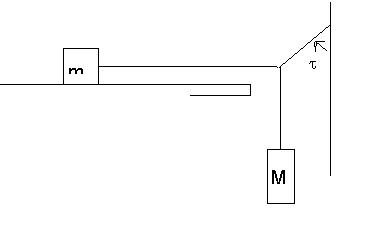PHYSICS 1301
(Sample) EXAM 1
Dr. Mills
Fall 2000
Answer 4 of the following
questions for full credit on this exam. Show all your work. Circle the
answer to each part of each problem you work. Work an additional problem
as an extra-credit problem.
1. A model rocket is launched
straight upward with an initial speed of 50 m/s. It accelerates with a
constant acceleration of 2.0 m/s2 until its engine stops at
an altitude of 150 m.
(1) What is the maximum
height reached by the rocket?
(a) 102 m (b) 158 m (c)
308 m (d) 408 m (e) 508 m
(2) How long after lift-off
does the rocket reach its maximum height?
(a) 1.24 s (b) 2.84 s (c)
5.68 s (d) 8.52 s (e) 10.55 s
(3) How long is the rocket in
the air?
(a) 5.67 s (b) 7.93 s (c)
8.52 s (d) 10.45 s (e) 16.45 s
(4) If the rocket has at the
time the engines stop a lateral velocity of 3.5 m/s (which it accelerates
to uniformly from time of launch) how far away from the launch site will
the rocket travel?
(a) 19.8 m (b) 27.8 m (c)
36.5 m (d) 47.6 m (e) 57.7 m
2. A mass M2 is attached
to the suspended mass M1 by a string and a pulley as shown in
the figure. M2 is also attached to mass M3 on the
inclined plane. The pulleys are massless and frictionless. Coefficients
of friction are as shown. Determine
(5) the tension T1
(a) 6.8 N (b) 16.2 N (c)
19.6 N (d) 23.0 N (e) 28.6 N
(6) the
tension T2
(a) 6.8 N (b) 16.2 N (c)
19.6 N (d) 23.0 N (e) 28.6 N
(7) the direction of acceleration
of mass M1?
(a) up (b) down (c) doesn't
move (d) sideways (e) I don't know
(8) the magnitude of the
acceleration.
(a) 0 m/s2 (b)
1.2 m/s2 (c) 2.0 m/s2 (d) 2.7 m/s2 (e)
3.0 m/s2

3. A polished granite block
of mass 1 kg rests on a steel table and is connected by a light cord to
a mass, M, and a wall as in the figure. Given that the angle t
= 45o
(9) what is the maximum
value M can have before it and m begin to move?
(a) 0.1 kg (b) 0.3 kg (c)
0.75 kg (d) 1.5 kg (e) 2.7 kg
(10) Would your answer be
different if the apparatus were placed on Mars?
(a) Yes (b) No (c) maybe
(d) when it rains (e) none of these!
(11) Explain why!! (write
a paragraph) Assume that the kinetic coefficient of friction is 0.200 and
the static coefficient of friction is 0.300 for polished granite against
steel
Prob 3 figure:

4. A glider is towed by a
single engine airplane. The tow rope makes an angle of 30o to
the horizontal. If the tow plane pulls on the rope with a force of 5000
N at it’s highest attainable altitude before releasing the glider and the
glider does not move up or down,
(12) what is the weight
of the glider?
(a) 441 kg (b) 225 kg (c)
2500 N (d) 5000 N (e) 4300 N
(13) What is the horizontal
acceleration?
(a) 0 m/s2 (b)
9.8 m/s2 (c) 16.9 m/s2 (d) 19.6 m/s2 (e)
22.7 m/s2
(14) if wind resistance provides
a retarding force proportional to the velocity of the glider where the
constant of proportionality, k, is 100 kg/s (i.e. air friction is = kv),
what is the maximum speed before the glider is released?
(a) 16.8 m/s (b) 22.7 m/s
(c) 31.5 m/s (d) 43.0 m/s (e) 52.1 m/s
5. Batman chases the Joker off
a cliff. If Batman starts accelerating at 15 m/s2 from a stop
to try and catch the Joker who is traveling at a constant velocity and
both start 100 m from the edge of the 100 m high cliff:
(15) How fast must the
Joker be traveling in order for Batman to just not quite catch him before
he goes over the edge of the cliff?
(a) 6.67 m/s (b) 10.4 m/s
(c) 18.75 m/s (d) 27.4 m/s (e) 38.7 m/s
(16) How far will Batman go
if he continues to accelerate horizontally before he hits the ground below
the cliff?
(a) 75 m (b) 102 m (c)
124 m (d) 277 m (e) 560 m
(17) What is his speed (magnitude
of velocity) when he hits the ground?
(a) 35 m/s (b) 44 m/s (c)
123 m/s (d) 130 m/s (e) 152 m/s
(18) At what angle is he traveling
(relative to horizontal) when he hits the ground at the base of the cliff?
(a) -10o (b)
-15o (c) -20o (d) -30o (e) -40o
6. A projectile is fired
up an inclined plane which is angle f
to the horizontal with an initial velocity of Vo at an angle
do
with respect to the horizontal (do
> f).
Show that the projectile will travel a distance d up the inclined plane
where:
d = 2 Vo2
cos do
sin (do
– f)
/ [g cos2 f]
Quantities you may need to use
on this test – if you need others ask me!!
g is the acceleration of
gravity on the earth (9.8 m/s2) G = 6.67 x 10-11
Nm2/kg2


